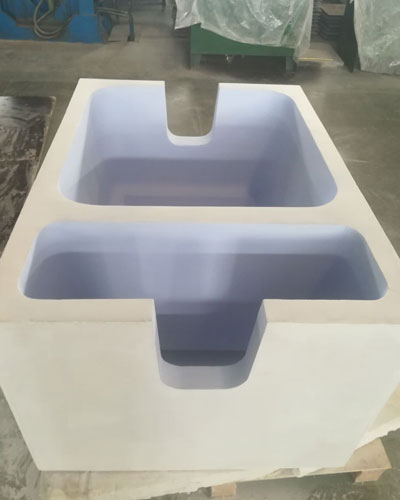Some factories use ceramic filter devices. The outer shell of the ceramic filter devices is welded with steel plates, lined with aluminum silicate fiber, and then built with a layer of light refractory bricks, and the inside is brushed with talcum powder. The inner cavity of the filter is divided into two compartments A and B by porous ceramic plates or silicon carbide plates. Room A is the filter room, the filter tube is assembled on the partition hole, and the assembly part is sealed with aluminum silicate fiber felt. Room B is a storage room for collecting filtered metal. There is a heating cover on the upper part of the filter with a resistance heating wire inside. The thermocouple continuously measures the temperature, and the electronic potential difference controls the metal temperature in the filter. There is a discharge eye at the bottom of the filter. There are two types of all working indenters. Install filter tubes in the filter room, and the number of installations depends on the needs. The melt enters the filter chamber A connected to it along the launder from the static furnace, then seeps out through the micropores of the filter tube, collects in the storage chamber, and finally enters the crystallizer through the flow plate.

Pay attention to the following issues when designing and using ceramic filters according to product requirements:
- Choose a filter material with appropriate pore size. Improper improvement of the filtration accuracy will increase the tendency of the ingot to produce coarse crystals and feather crystals.
- From improving the filtering effect and service life of the filter, the effective filtering area of the filter should be increased as much as possible, that is, the multi-tube filter should be used.
- The filter tube should be installed tightly and seamlessly to prevent short circuits.
- Before use, the filter should be fully preheated, and the preheating temperature should not be lower than 720℃. In the casting and melting, heat preservation should also be paid to prevent condensation.
- In order to meet the requirements of fine filtration and to improve the service life of the filter, it is best to use a ceramic foam filter plate to coarsely filter the melt before using a ceramic filter.
- Reasonably arrange production, and try to avoid obstructing the effective use of filters due to frequent alloy transfers.
- When filtering, it is strictly forbidden to sprinkle flux powder in the filter and the static furnace launder.
- During the casting process, the static pressure head of the melt should rise steadily to prevent the fluctuation of the liquid level and the vibration and impact of the mold.
- Before finishing the casting, the scum on the metal surface of the filter should be removed to avoid clogging of the filter tube.
- Prevent secondary pollution of the filtered melt.

